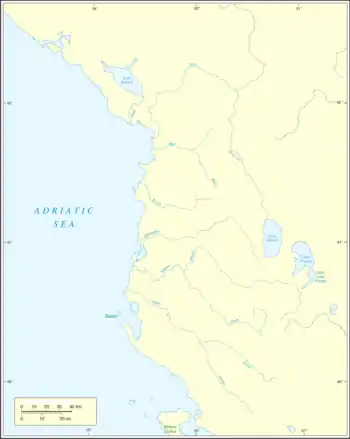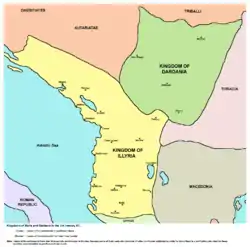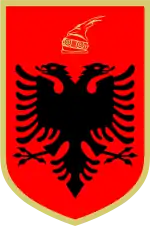Ardiaei
The Ardiaei were an Illyrian people residing on territory of present-day Albania, Kosovo, Montenegro, and Bosnia and Herzegovina between Adriatic coast on the south, Konjic on the north, along the Neretva river and its right bank on the west, extending to Lake Shkodra to the southeast.[1][2] From the 3rd century BC to 168 BC the capital cities of the Ardiaean State were Rhizon and Scodra.[3][4]
The Ardiaean kingdom was transformed into a formidable power—both by land and sea—under the leadership of Agron. During this time, Agron invaded part of Epirus, Corcyra, Epidamnos and Pharos in succession, establishing garrisons in them.[5] The Ardiaean realm became one of Rome's major enemies, and the primary threat in the Adriatic Sea. A series of wars were fought between the Roman Republic and the Illyrian (Ardiaean-Labaeatan) kingdom in the 3rd–2nd centuries BC. Polybius (203 BC–120 BC) writes that they were subdued[6] by the Romans at events that occurred at 229 BC. The Epitome of Livy reports that Roman consul Fulvius Flaccus put down an uprising in 135 BC undertaken by Ardiaei and Pleraei in Roman Illyria.[7][8]
In earlier times the Ardiaei were enemies of the Autariatae for a long period over salt source.[9] Appian (95–165) writes that the Ardiaei were destroyed by the Autariatae and that in contrast to the Autariatae they had maritime power.[10]
Etymology
The Ardiaei are attested since the 3rd century BC. They often appears in ancient accounts describing the Illyrian Wars and Macedonian Wars. Their name was written in Ancient Greek as Ἀρδιαῖοι, Ardiaioi, or Οὐαρδαῖοι, Ouardaioi, and in Latin as Vardiaei or Vardaei.[11] The tribal name Ardiaei may be related to the Latin ardea meaning "heron", a symbol of animal totemism.[12]
Original location

i n t h e 3rd – 2nd
c e n t u r i e s B C E
Accounts in ancient sources create much confusion about the location of the Ardiaean original homeland.[13] They were located in the area of southern Illyria, somewhere in present-day Montenegro,[14] most likely around the gulf of Rhizon, although Strabo places them in the right bank of the Neretva.[15] Their initial inland residence was located along the Naro River up to the Konjic region,[1] in present-day Bosnia and Herzegovina.
The name of the town Čapljina is another feature suggesting that the original homeland of Ardiaei might indeed have been the Neretva valley region. Specifically, there is a town in Bosnia and Herzegovina situated in the wider Neretva valley region (the original homeland of ancient Illyrian people of Ardiaei), called Čapljina, and its name derives from čaplja, which in modern Bosnian language means 'heron'. The Latin word for heron is ardea, a word that bears striking similarity with the name of Ardiaei, and should not be excluded altogether as its potential cognate.
This hypothesis opens up many possibilities for the interpretation of the original homeland of the Ardiaei and the etymology of their name. For example, heron might have had totemic pagan value among the Illyrians inhabiting that region, due to its presence in this area, and it is not implausible to conclude that one of those Illyrian peoples named itself after a heron, the Ardiaei. The Latin word ardea might be a Latin translation of some original Illyrian word for 'heron' that Romans found when they settled in this area, or the 'ardea' itself could have been an Illyrian word taken by Romans, who might have slightly altered it and integrated it into their language, Latin. Indeed, the word Ardiaei is found in ancient Greek sources predating the arrival of Romans and their language to the Illyrian lands. It is also possible that ancient Illyrians or Romans named this place the place of heron(s), and the Slavic settlers, who settled in the former Illyrian lands around 6th century A.D. translated the name of this place into their language(s), which in turn gave Čapljina, "the place of heron(s)".[16]
History

Due to widespread piracy perpetrated in the Adriatic by the Ardiaei and other Illyrian tribes, the Romans campaigned against them in the events of the Illyrian Wars. They were viewed as heavy drinkers in comparison, by the Greeks.[17]
In earlier times the Ardiaei were enemies of the Autariatae for a long period over salt source.[9]
The Ardiaei had briefly attained military might, during 230 B.C. under the reign of king Agron (an Ardiaean by tribal origin). His widow, Queen Teuta attempted to gain a foothold in the Adriatic but failed due to Roman intervention. Historic accounts hold that King Agron was hired[18] by king Demetrius of Macedonia repel the invasion of Macedonia by the invading Aetolians. The Ardiaei had 20 decuriae.
The ancient geographer, Strabo, lists the Ardiaei as one of the three strongest Illyrian peoples – the other two being the Autariatae and the Dardani. Strabo writes;[19]
“Because they pestered the sea through their piratical bands, the Romans pushed them back from it into the interior and forced them to till the soil. But the country is rough and poor and not suited to a farming population, and therefore the tribe has been utterly ruined and in fact has almost been obliterated. And this is what befell the rest of the peoples in that part of the world; for those who were most powerful in earlier times were utterly humbled or were obliterated, as, for example, among the Galatae the Boii and the Scordistae, and among the Illyrians the Autariatae, Ardiaei, and Dardanii, and among the Thracians the Triballi; that is, they were reduced in warfare by one another at first and then later by the Macedonians and the Romans.”
King Agron, son of Pleuratus who belonged to the ruling house of the Ardiaei, disposed of the most powerful force, both by land and sea, of any of the kings which had reigned in Illyria before him.[5]
Ardiaean dynasty
The following list reports the members of the Ardiaean dynasty documented as such in ancient sources:[20]
- Pleuratus (fl. c. 280 BC): father of Agron
- Agron (– 231 BC): married Triteuta with whom he had Pinnes; he then divorced his first wife and married Teuta
- Teuta (231 – 228): married Agron and was queen regent for Pinnes after Agron's death
- Demetrius (fl. c. 228 – 219 BC): married Triteuta and was king regent for Pinnes after Teuta's abdication
- Pinnes (220 – after 217): son of Agron and Triteuta
The branch of Scerdilaidas, and his successors Pleuratus III and Gentius, is generally considered a Labeatan dynasty, that emerged after the fall of Agron and Teuta in the First Roman–Illyrian War. Indeed, the Illyrian king Gentius is also attested as reigning among the Labeatae.[21]
See also
| Wikimedia Commons has media related to Illyria & Illyrians. |
References
- Šašel Kos 2005, p. 320: "The Ardiaei were certainly also settled in the hinterland, along the Naro River at least as far as the Konjic region..."
- Wilkes 1992, p. 188: "probably the result of pressure from new Illyrian groups, including the Ardiaei and Delmatae, moving towards the Adriatic..."
- Vickers 1999, p. 2.
- Dyczek 2020, pp. 423–433.
- Wilkes 1992, pp. 156–157: "Agron, son of Pleuratus belonged to the ruling house of the Ardiaei. 'Agron was king of that part of Illyrian which borders Adriatic sea, over which Pyrrhus and his successors had held sway. In turn he captured part of Epirus and also Corcyra, Epidamnus and Pharos in succession, and established garrisons in them'(Appian Illyrike 7). The new power disposed of the most powerful force, both by land and sea, of any of the kings who had reigned in Illyria before him', we are informed by Polybius (2.2)"
- Plb. 2.11, "The Romans, taking the Epidamnians under their protection, advanced into the interior of Illyricum, subduing the Ardiaei as they went."
- vardaei-geo
- Dzino 2010, p. 64.
- Wilkes 1992, p. 139: "... describes a long-running feud between the Autariatae and the Ardiaei over the possession of a salt-source near their common border ..." p. 223: "The salt source that was a cause of conflict between the Illyrian Ardiaei and Autariatae may be that at Orahovica in the upper Neretva valley near Konjic."
- App. Ill. 1, "In like manner the Ardiæi, who were distinguished for their maritime power, were finally destroyed by the Autarienses, whose land forces were stronger, but whom they had often defeated."
- Wilkes 1992, p. 216: "The Ardiaei, or Vardaei as they were known to the Romans, 'once the ravagers of Italy' and now reduced to a mere."
- Elsie 2015, p. 2: "Their name may be related to the heron (Lat. ardea) as a totem symbol."
- Dzino 2010, p. 46.
- Šašel Kos 2005, p. 170: "...who located the Ardiaei in the southern Illyrian area in present-day Montenegro..."
- Dzino 2005, p. 58: in the vicinity of the Rhizonic gulf... Strabo locates them on the right bank of Neretva."
- Adzanela (Axhanela) Ardian, Illyrian Bosnia and Herzegovina-an overview of a cultural legacy, 2004, Centre for Balkan Studies, Online Balkan Centre : https://www.academia.edu/2490281/Illyrian_Bosnia_and_Herzegovina-an_Overview_of_a_Cultural_Legacy_Ancient_Illyrians_of_Bosnia_and_Herzegovina
- Wilkes 1992, p. 221: "To the Greek world the Illyrians appeared heavy drinkers, from the drinking bouts of the Ardiaei from which intoxicated men were conveyed home by their women, who had also participated, to the overindulgence of their kings ..."
- The Cambridge Ancient History, Volume 7, Part 1, by Frank William Walbank, 1984, ISBN 0-521-23445-X, page 452
- Strab. 7.5
- Dzino 2010, p. xvii; Dzino 2014, p. 57; Mesihović & Šačić 2015, p. 49; Šašel Kos 2007, p. 133.
- Dzino 2010, p. xvii; Dzino 2014, p. 57; Waterfield 2014, p. 57; Šašel Kos 2007, p. 137.
Bibliography
- Dyczek, Piotr (2020). "Rhizon – capital of the Illyrian kingdom – some remarks". In Krzysztof Jakubiak; Adam Lajtar (eds.). Ex Oriente Lux. Studies in Honour of Jolanta Młynarczyk. Wydawnictwa Uniwersytetu Warszawskiego. pp. 423–433.
- Dzino, Danijel (2005). "Late Republican Illyrian Policy of Rome 167-60 BC: the Bifocal Approach". In C. Deroux (ed.). Studies in Latin Literature and Roman History. 12. Latomus. pp. 48–73. ISBN 9782870312285.
- Dzino, Danijel (2010). Illyricum in Roman Politics, 229 BC–AD 68. Cambridge University Press. ISBN 978-0-521-19419-8.
- Dzino, Danijel (2014). "'Illyrians' in ancient ethnographic discourse". Dialogues d'histoire ancienne. 40 (2): 45–65. doi:10.3917/dha.402.0045.
- Elsie, Robert (2015). "The Early History of Albania" (PDF). Keeping an Eye on the Albanians: Selected Writings in the Field of Albanian Studies. Albanian Studies. 16. ISBN 978-1-5141-5726-8.
- Ferone, Claudio (2004). "Appiano, "Illyr." 3 e la pirateria illirica nel IV sec.A.C." [Appian, "Illyr." 3 and the Illyrian piracy in the 4th century BC]. Hermes (in Italian). Franz Steiner Verlag. 132 (3): 326–337. JSTOR 4477612.
- Hammond, N. G. L. (1982). "Illyris, Epirus and Macedonia". In John Boardman; N. G. L. Hammond (eds.). The Cambridge Ancient History: The Expansion of the Greek World, Eighth to Sixth Centuries B.C. III (part 3) (2 ed.). Cambridge University Press. ISBN 0521234476.
- Hammond, N. G. L. (1994). "Illyrians and North-west Greeks". The Cambridge Ancient History Volume 6: The Fourth Century BC. Cambridge University Press: 422–443. doi:10.1017/CHOL9780521233484.017. ISBN 9780521233484.
- Katičić, Radoslav (1976). Ancient Languages of the Balkans. Mouton. p. 158.
- Mesihović, Salmedin; Šačić, Amra (2015). Historija Ilira [History of Illyrians] (in Bosnian). Sarajevo: Univerzitet u Sarajevu [University of Sarajevo]. ISBN 978-9958-600-65-4.
- Šašel Kos, Marjeta (2005). Appian and Illyricum. Narodni Muzej Slovenije. ISBN 978-961-6169-36-3.
- Šašel Kos, Marjeta (2007). "The Illyrian King Ballaeus – Some Historical Aspects". In Berranger, Danièle; Centre de recherches sur les civilisations antiques (eds.). Épire, Illyrie, Macédoine: Mélanges offerts au Professeur Pierre Cabanes. Presses Universitaire Blaise Pascal. ISBN 2-84516-351-7.
- Stipčević, Aleksandar (1974). The Illyrians: history and culture (1977 ed.). Noyes Press. ISBN 978-0815550525.
- Vickers, Miranda (1999). The Albanians: a modern history. New York: I. B. Tauris. ISBN 978-1-86064-541-9.
- Wilkes, John J. (1992). The Illyrians. Oxford, United Kingdom: Blackwell Publishing. ISBN 0-631-19807-5.
- Waterfield, Robin (2014). Taken at the Flood: The Roman Conquest of Greece. OUP Oxford. ISBN 0-19-166414-6.
Further reading
- Severyn Bernolak; Vladoila Kolarić (1912). Iz povjesti Bosne i Hercegovine: Ardijejci. vlast. nakl.
